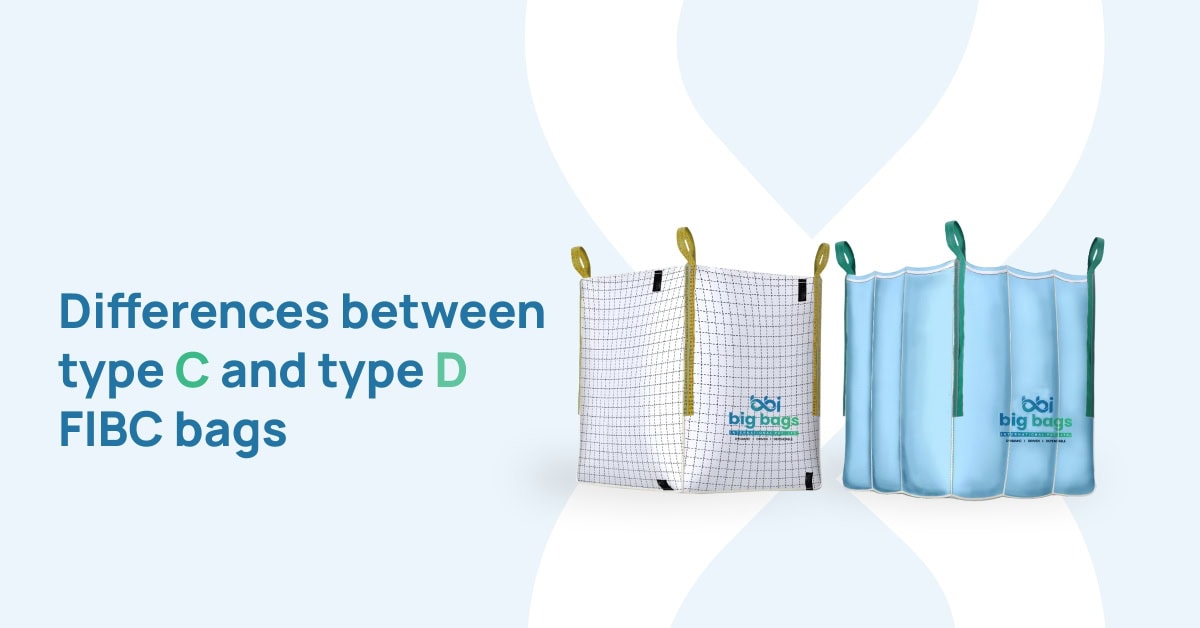FIBC bags (also called bulk bags or jumbo bags) are versatile bulk packaging sacks used across various industries to contain, store, or transport granular, powdered, and dry flowable material.
They’re often made with thick woven strands of oriented polypropylene (PP) fabric, making them a durable, practical, and sustainable choice for bulk packaging needs.
When FIBC bags are either filled with and discharged of the flowing powdered or granular material, friction against the fabric causes a buildup of static electricity. In such cases, an FIBC bags manufacturer may suggest using Type C and Type D conductive bulk bags to avoid the safety risks this may pose.
The following article helps you understand the difference between Type C FIBC and Type D FIBC bags so you can choose the best one for your operation.
Types of FIBC Bags
FIBC bags are designed to hold a variety of materials. The type of FIBC bag you choose depends on a facility’s safety policies against electric shocks, fire breakouts, or explosions.
The standard categorizing system for FIBCs uses letters A, B, C, and D based on their anti-static abilities. Each FIBC bag type offers varying degrees of electrostatic protection and has different physical properties.
- Type A: These are standard bulk bags made of woven polypropylene. They’re sturdy but offer no static protection; hence, they’re strictly used only to transport non-flammable products.
- Type B: They’re made with polypropylene woven material as Type A but come with an additional low breakdown voltage material to dissipate brush discharges and sparks.
- Type C: These conductive FIBCs are made from polypropylene fabrics interwoven with conductive threads designed to control electrostatic charges by grounding them.
- Type D: These are made from woven static and anti-static dissipative fabrics that allow electrostatic charge to scatter in the atmosphere without needing to be grounded like in Type C, hence preventing sparks or brush discharges.
Differences between Type C FIBC and Type D FIBC Bags
Type C and Type D FIBCs are static protective bulk bags that are designed to protect your product, people, and business against the hazards created by static electricity.
We’ll look at each bag and its benefits to better understand their differences.
What Is a Type C FIBC Bulk Bag?
A Type C FIBC bulk bag (also known as a conductive FIBC or groundable bulk bag) is constructed from non-conductive polypropylene fabric interwoven with conductive yarns to form a grid pattern.
Type C FIBC bags must compulsorily be electrically grounded during filling and emptying so as to efficiently dissipate the static electricity to the ground.
Benefits of Type C FIBC Bags :
- Used to transport flammable powders safely
- Can be used safely when flammable solvents or gases are around
- Prevents brush discharges and sparks during emptying of the bulk bag
- Less expensive than Type D FIBC bags
What Is a Type D FIBC Bulk Bag?
A Type D FIBC bulk bag (also called an anti-static bulk bag or Crohmiq dissipative bag) is made from quasi-conductive yarns that disperse static charges in the atmosphere with low-energy corona discharge that prevents the occurrence of fires, sparks, and brush discharges.
Type-D FIBC bags dissipate static charges without the need for the bulk bag to be grounded.
Benefits of Type D FIBC Bags :
- Used to safely transport flammable powders and combustible materials
- Can be safely used in combustible environments or around flammable vapours and gases
- Prevents brush discharges and sparks without the need for grounding
- Safest type of FIBC as it can handle combustible products in any environment
Also Read : Application of FIBC Bags in Bulk Transportation
Safety and Usage of Type C and Type D FIBC Bags :
Every inch of the conductive elements of Type C FIBCs must be interconnected with the grounding tab throughout the filling or discharging process.
Whereas Type D FIBC bags are constructed to be complete static dissipaters, meaning they not only efficiently resist static charge but also actively disperse the build-up in the atmosphere.
Safe Usage of Type C
- Type C bulk bags can be used to store and ship flammable powders material also.
- They can be safely used when flammable solvents or gases are present around the bag.
Unsafe Usage of Type C
- The bags may not be used when their surface has been damaged or if there’s no proper grounding.
- Since these bags are usually handled manually, chances of human error are high. So, there may still be a small chance of hazards happening.
Safe Usage of Type D
- They’re safe to use irrespective of the sensitive flammable environment of the bag.
- They’re safe to package and ship chemical, pharmaceutical, and organic goods.
Unsafe Usage of Type D
- They’re not safe to use if the surface of the bag is contaminated or coated with conductive products, such as water or grease.
- It’s best not to use the bag if it’s physically damaged or needs refurbishing.
Type C FIBC or Type D FIBC: Which One Should You Select?
Type C FIBC bags are the oldest and most common bag type used in mitigating static discharges. If your business facility has an existing grounding zone, and your employees are trained in careful execution of the FIBC bags, then it is feasible to go with Type C bags.
Type D FIBC bags are the most secure anti-static bags available in the industry. If you require a bag that can safely handle hazardous materials with less manpower while eliminating the risks of human errors, then Type D FIBC is your best choice.
If you need more information on the types of bags and their uses and customizations, then Big Bags International is here for you. Being a professional FIBC bags manufacturer and supplier, we will help you make the best choice for your business. Check out our website and learn more today.

